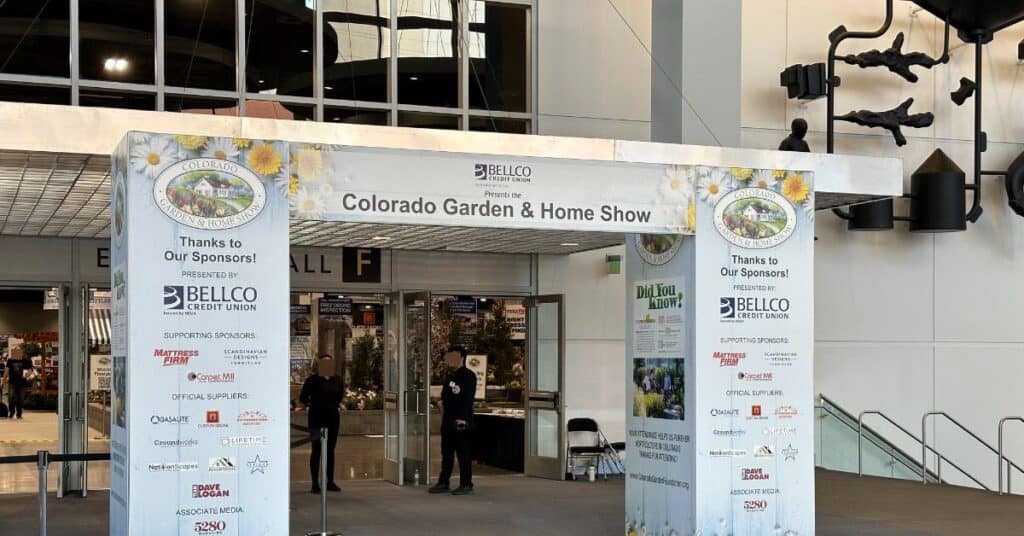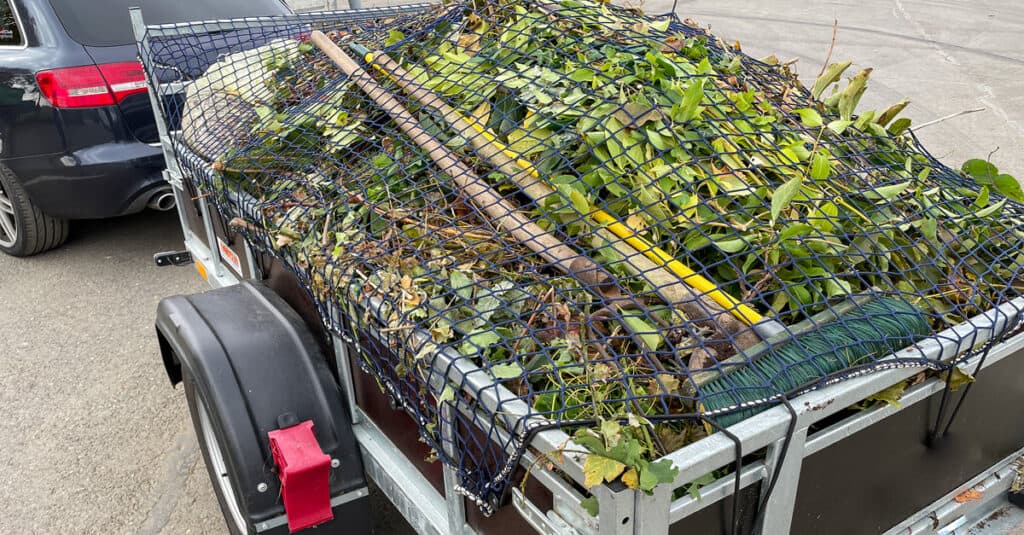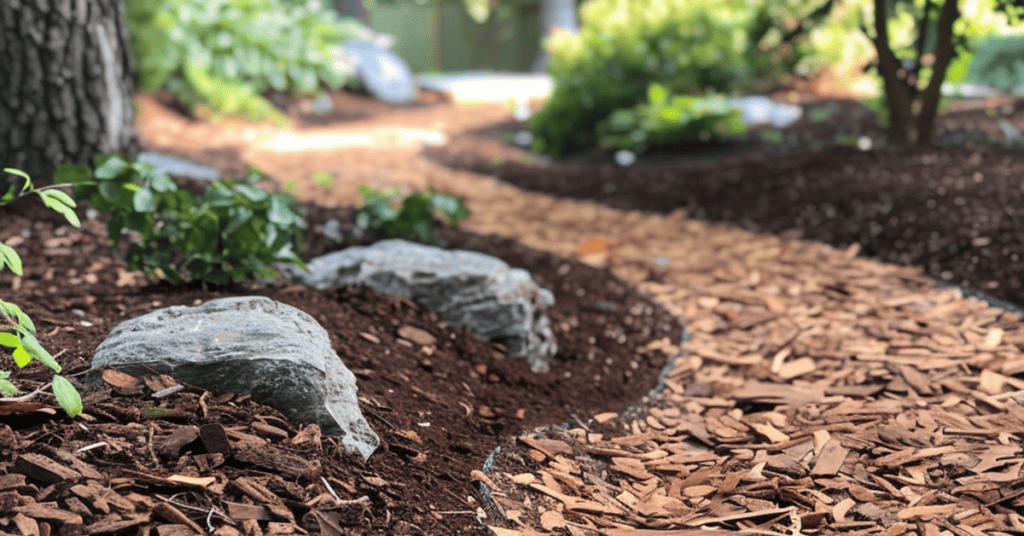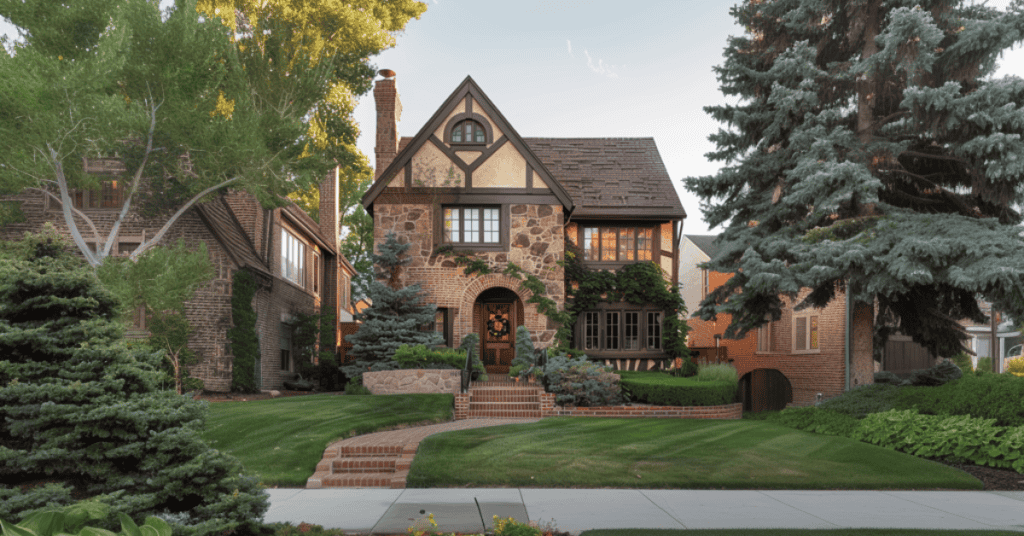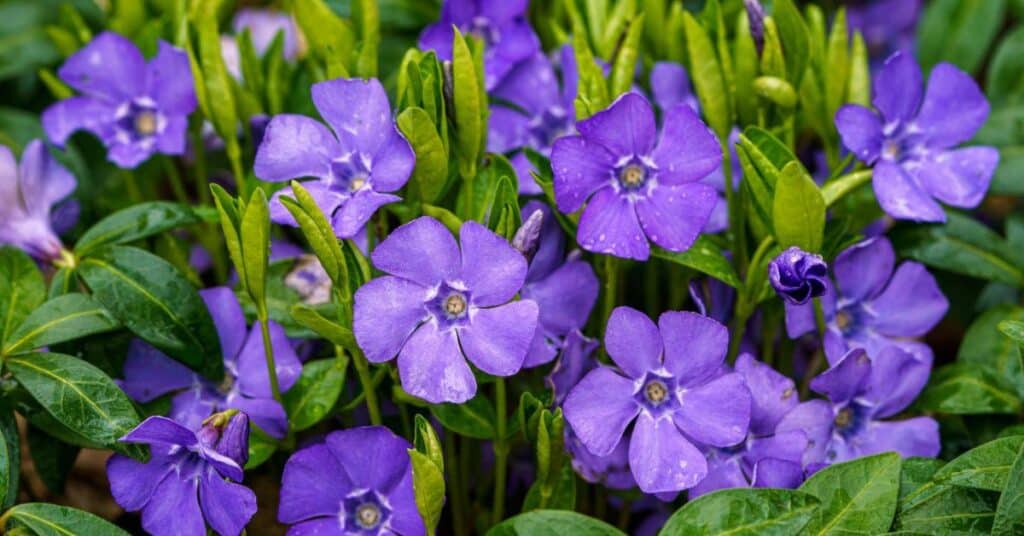Decorative Landscaping Rock Without Breaking the Bank in Denver
Landscaping rocks offer various textures, colors, and sizes, making them a versatile choice for your Front Range landscaping project. Each type of landscape rock has specific characteristics that can impact its suitability and cost-effectiveness for your landscape design needs. We’ll dive into the virtues and drawbacks of each rock – but first, let’s take a look at the costs of different landscaping stone options.
Landscaping Rock Costs
Note that the prices of landscaping rock will vary greatly by not only the type and size of the rock, but also the quality of the rock and the retailer or wholesaler. Rocks are generally sold either by cubic yard or by cubic ton.
Use this table to get a rough idea of the relative cost of each rock type when compared to other types of rock.
|
Landscape Stone |
Cost ($)/Ton |
|---|---|
|
Crushed Limestone |
$25 – $50 |
|
Decomposed Granite |
$35 – $70 |
|
Landscape Glass |
$2,000 – $5,000 |
|
Lava Rock |
$150 – $200 |
|
Pea Gravel |
$25 – $50 |
|
River Rock |
$75 – $300 |
Calculating the Cost of Landscaping Rock
First, measure the outdoor space to be covered. Most rocks are sold by cubic yard or ton. Divide the total area by the size, depth, and type of rock to get the amount needed. Then multiply by the cost per cubic yard or ton to estimate the total price.
Crushed Limestone
Crushed limestone is a pale material often used in driveways and paths. This crushed stone has a rough texture which helps it bind well, providing a solid surface. This type of rock offers colors like white, yellow, and gray.
Crushed limestone is inexpensive and easy to work with. It also enhances soil pH, benefiting plants. However, dust from crushed limestone can be an issue during dry conditions.
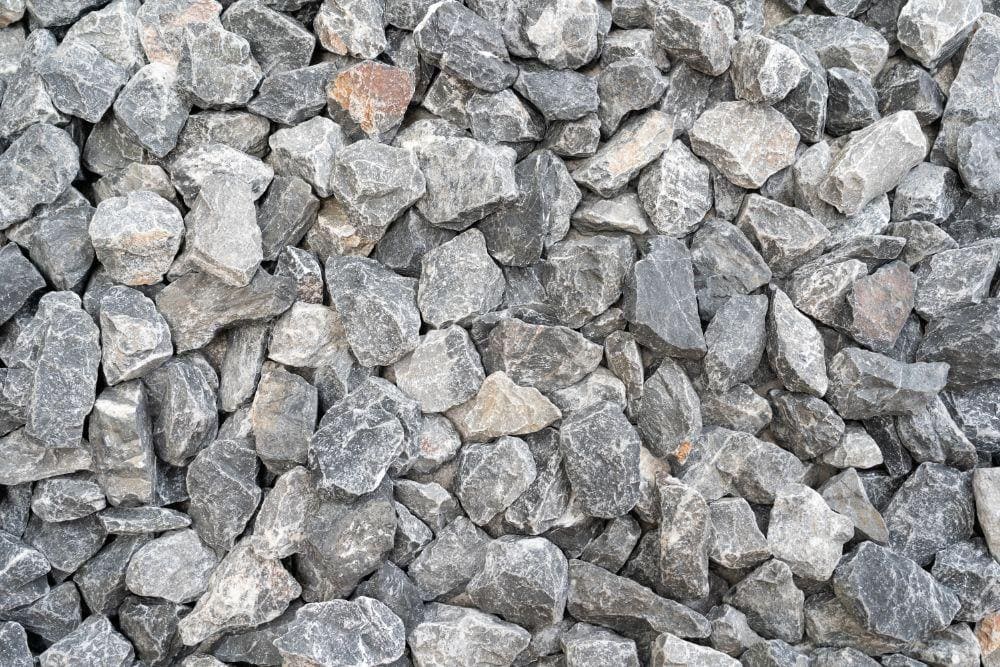
Crushed Limestone is Among the Cheapest Rock Choices Available (Along with Pea Gravel)
Decomposed Granite
Decomposed granite (DG) is a natural stone formed from granite fragments. It’s available in different colors, including tan, brown, and gray. This material has a more rustic texture, making it ideal for pathways and patios.
This landscape rock compacts easily, providing a stable base. Decomposed granite is also relatively affordable, making it a popular choice for budget-conscious homeowners. However, it can become muddy when wet, so proper drainage is essential.

Decomposed Granite Compacts Well and Has Great Drainage Properties But Will Break Down Over Time
Pea Gravel
Pea gravel consists of small, rounded stones about the size of peas. These rocks come in various colors such as gray, white, tan, and brown. Due to their smooth texture, they are frequently used in garden beds, driveways, and walkways.
Pea gravel is one of the cheapest landscaping rocks available. It’s also easy to install and maintain. Their versatility and affordability make them appealing for many landscaping projects.
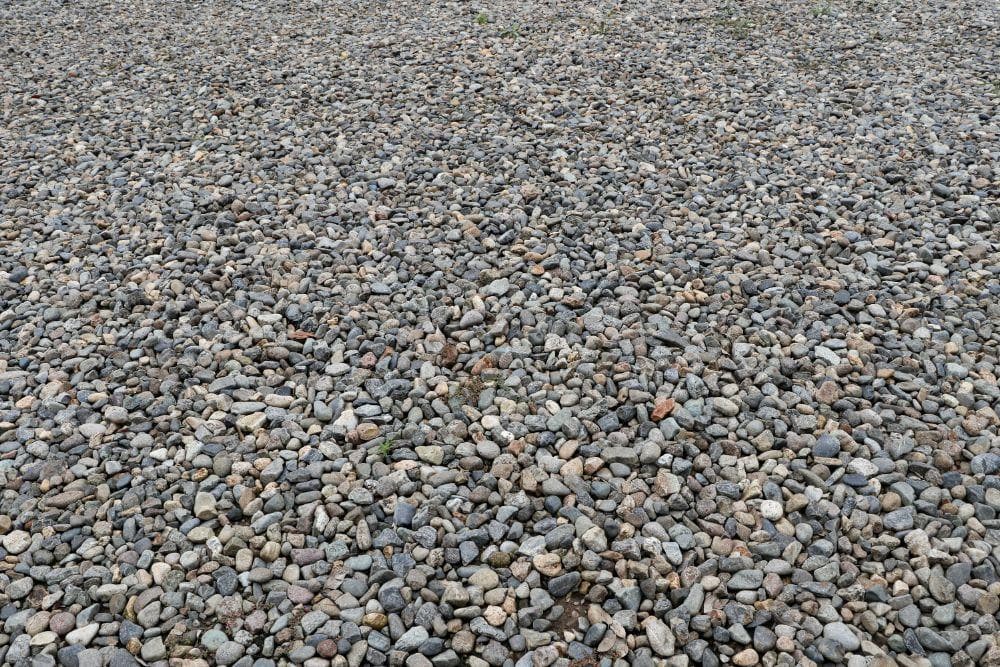
Pea Gravel is Among the Most Used Rocks Used in Landscape Design Due to its Relatively Low Cost and Versatility
Landscape Glass
Landscape glass is a vibrant, decorative element to landscaping with its wide range of colors and reflective qualities. It isn’t the cheapest landscaping rock however. Its very high cost makes it best used as an accent to enhance your landscaping as opposed to being the main feature of your landscaping.
Made from recycled glass, it is an environmentally conscious choice that is also highly durable and long-lasting. Landscape glass requires minimal maintenance, as it does not degrade, erode, or attract pests.
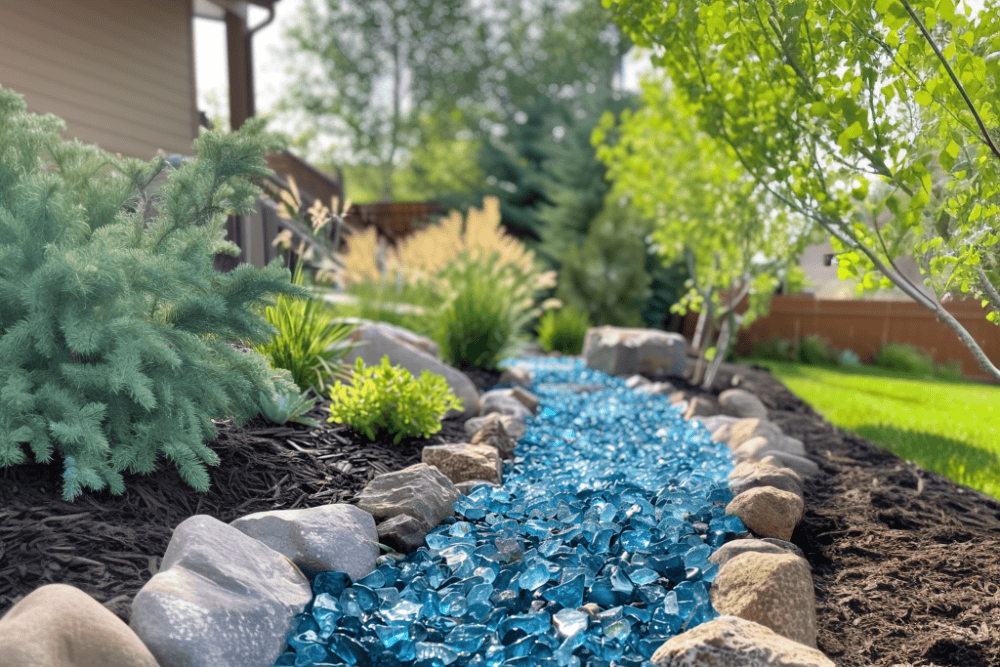
Closeup of Landscape Glass in a Backyard to Enhance the Overall Landscape Design
River Rock
River rocks are smooth, rounded stones often used in water features and garden beds. They come in an array of colors, including gray, blue, and green. These river stone rocks vary in size, typically ranging from 3/4 inch to 2 inches in diameter.
Although not the cheapest option, river rock adds a natural, polished look to landscapes. They are durable and require minimal maintenance, making them a long-term investment.
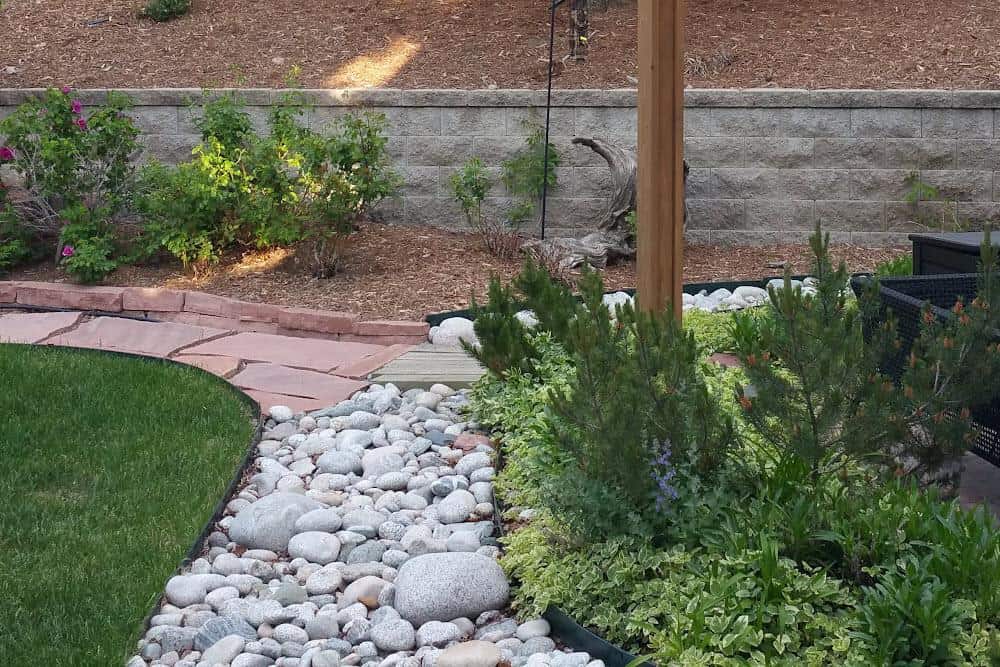
River Rock Used in a Drainage Area in a Colorado backyard
Lava Rock
Lava rocks are lightweight, porous stones formed from volcanic activity. It is a beautiful decorative rock that is available in red, black, and other dark colors. These rocks create dramatic visual effects in a garden bed and around fire pits.
While more expensive, lava rock retains moisture and helps with soil temperature regulation. Their unique texture and appearance make them a bold choice for landscaping projects.
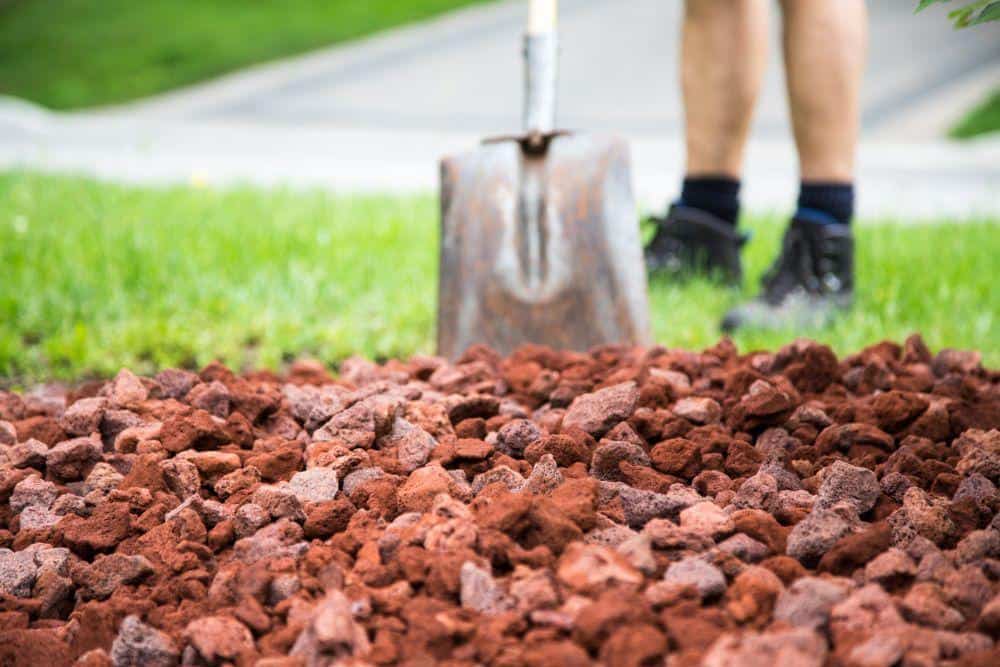
Lava Rocks Add A Colorful Look to Your Landscaping Project
Factors Influencing Rock Prices
Several factors influence the prices of landscaping rocks. These factors include transportation and availability, size and weight considerations, and maintenance and durability.
Delivery Costs
The cost of transportation significantly impacts the price of landscaping rocks. If rocks are sourced from faraway quarries, the shipping expense can increase the overall cost. Rocks that are locally available are usually more affordable due to reduced transportation costs.
Size and Weight Considerations
Size and weight of rocks are critical factors in pricing. Larger and heavier rocks are more expensive due to the increased effort required for extraction, transportation, and installation. For instance, a single large boulder costs more than small pebbles simply because of its size and weight making it more difficult to manage.
Maintenance and Durability
Maintenance and durability affect the long-term costs of landscaping rocks. Durable rocks that withstand weather conditions and require minimal upkeep are more cost-efficient over time. For example, river rocks are known for their longevity and low maintenance needs, making them a wise investment.
Design Considerations for Rock Landscaping
Color and Aesthetic Appeal
The color of rocks can significantly impact the overall aesthetic of a landscape. Pea gravel, for example, comes in a variety of earth tones such as gray, tan, and white. This variety allows it to blend seamlessly into garden beds and pathways, creating a natural look.
River rocks add a smooth, polished texture, often found in shades of brown, green, and gray. These are ideal for water features or as accent pieces. If you’re looking for a red rock to accentuate your landscape, lava rocks may be a good fit. Lava rocks come in a rich red or black hue. Though slightly more expensive, their unique color makes them stand out.
Choosing colors that match or complement existing elements in the garden, like plants and structures, ensures a harmonious design. Mixing different rock colors can create dynamic and visually appealing patterns.
Functionality and Landscape Structure
Rocks serve different functions in landscaping. Crushed gravel is excellent for creating stable pathways and driveways due to its compactable nature. It offers a practical solution for large areas needing coverage without sacrificing looks.
Pea gravel is versatile and works well in various settings, from garden beds to play areas. It provides good drainage and is comfortable to walk on, making it perfect for footpaths.
River rocks can be used to prevent soil erosion in garden beds and around water features. Their weight helps keep them in place, making them suitable for areas prone to heavy water flow.
Using rocks effectively involves considering how they will interact with plants and other features in the landscape. For instance, rocks around plant bases can aid in moisture retention and weed control.
Practical Benefits of Cheapest Rocks
Erosion Control and Drainage
Inexpensive rocks like pea gravel and crushed gravel are excellent for controlling erosion and providing good drainage. Placing these rocks on slopes or areas prone to water runoff helps prevent soil erosion.
Crushed gravel, in particular, allows water to pass through easily, reducing the risk of puddles and mud. This makes it suitable for areas that need consistent drainage. It’s also less likely to compact over time, maintaining its effectiveness.
Erosion control is critical in retaining soil and protecting plant roots. Rocks create barriers that slow down water flow, reducing soil displacement. This makes them highly effective in maintaining the integrity of your garden landscape.
Weed Growth Suppression
Cheap rocks like pea gravel and river rocks also help in suppressing weed growth. By covering the soil surface with a layer of these rocks, it limits the sunlight reaching the ground. This hinders weed germination and growth.
Installation and Maintenance Tips
Setting Up Garden Beds and Pathways
When setting up garden beds and pathways, it’s important to prepare the area well. Start by removing any grass and weeds. Lay down a landscape fabric to help prevent weed growth. The fabric also keeps rocks from sinking into the soil over time.
Once the fabric is in place, choose a rock type like pea gravel or crushed granite. Spread the rocks evenly to a depth of about 2-3 inches. For pathways, consider using edging materials to keep the rocks contained and maintain a clean look.
For garden beds, mix different rock sizes and consider adding larger stones as focal points. Rocks offer a low-maintenance option for covering soil, reducing the need for mulch or other organic materials.
Ongoing Rock Landscape Care
Maintaining a rock landscape requires regular attention. Periodically inspect the area for weeds that may have found their way through the landscape fabric. Pull them out promptly to keep the area tidy.
Rake the rocks occasionally to redistribute them and maintain an even coverage. If using rocks in pathways, a blower can help remove debris without disturbing the rocks too much. Over time, some rock areas may require additional rocks to keep the desired depth.
Watch out for erosion, especially on slopes. Adding more rocks or using a stabilizing grid can help prevent movement. With these steps, your rock landscape will remain an attractive, low-maintenance part of your garden.
Selecting Rocks for Specific Landscaping Features
Choosing the right rocks for different landscaping features ensures functionality and visual appeal. Certain rock types best meet the needs of water features, walkways, stepping stones, retaining walls, and edging.
Water Features and Waterfalls
For water features and waterfalls, smooth, rounded rocks are ideal. River rocks and pebbles create a natural and tranquil look. Their smooth surfaces allow water to flow easily, preventing splashes. This makes them an excellent choice for ponds, fountains, and artificial streams.
Larger boulders can be strategically placed to create dramatic effects or serve as the main structure in a waterfall. Additionally, black polished pebbles provide an ornamental touch around water features, enhancing aesthetic appeal.
Walkways and Stepping Stones
Walkways and stepping stones need rocks that are durable and flat. Flagstone and slate are popular choices for walkways due to their flat surfaces and natural look. These materials come in various shades, allowing for creative designs.
Pea gravel is another economical option for walkways. It provides a softer and more comfortable surface underfoot compared to larger rocks. Its small, smooth stones create a stable path that’s easy to walk on.
Retaining Walls and Edging
Crushed stone and decomposed granite are commonly used for retaining walls and edging. These materials are cost-effective and easy to work with. Pea gravel is also used around the perforated pipe that is part of the french drain system at the bottom of a retaining wall as it allows water to easily pass through to the pipe while keeping dirt and debris away.
River rocks can also be used for decorative edging around beds and gardens, offering a natural and polished look. As a larger rock, river rocks can also be used for the construction of gabion retaining walls due to their large but manageable size.
Where to Get Landscape Rocks in Denver Metro
Denver metro has numerous landscape supply stores that you can visit if you’re looking for decorative landscape rock for your outdoor space. These stores have just about every landscaping material that you could possibly need for your landscaping project.
Landscaping supplies for sale typically include organic mulch, edging materials, landscaping equipment, pavers, retaining wall blocks and more. Many of the suppliers will deliver the landscaping rock right to your home.
For a full list of landscape material suppliers that provide landscaping rock – please check out our directory of Denver Landscape Materials Suppliers for the Denver Metro Area.
